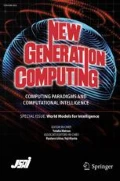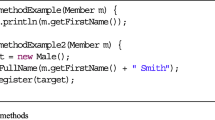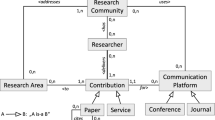Abstract
The majority of formal methods for distributed systems have their origins in the 1980’s and were targeted at the early generations of distributed systems. However, modern distributed systems have new features not found in the early systems, e.g. they areobject-oriented, havemobile components, aretime sensitive and are constructed according to advanced system development architectures, e.g.viewpoints models. A major topic of current research is thus, how to enhance the existing formal techniques in order to support these new features. This paper gives a tutorial level review of this research area. We particularly focus on the process algebra LOTOS and consider how the technique can be reconciled with these new features.
Similar content being viewed by others
References
Ates, A. F., Bilgic, M., Saito, S., and Sarikaya, B., “Using Timed CSP for Specification, Verification and Simulation of Multimedia Synchronization,”IEEE Journal on Selected Area in Communications, 14, pp. 126–137, 1996.
Alur, R. and Dill, D., “A Theory of Timed Automata,”Theoretical Computer Science, pp. 183–235, 1994.
Agha, G.Actors: A Model of Concurrent Computation in Distributed Systems, MIT Press, 1986.
America, P., “A Parallel Object-Oriented Language with Inheritance and Subtyping,”SIGPLAN Notices, 25, 10, pp. 161–168, October 1990.
Bolognesi, T. and Brinksma, E., “Introduction to the ISO Specification Language LOTOS,”Computer Networks and ISDN Systems, 14, 1, pp. 25–59, 1988.
Blair, G.S., Blair, L., Bowman, H., and Chetwynd, A.,Formal Specification of Distributed Multimedia Systems, University College Longon Press, September 1997.
Bowman, H., Boiten, E.A., Derrick, J., and Steen, M., “Viewpoint Consistency in ODP, A General Interpretation,” inFirst IFIP International Workshop on Formal Methods for Open Object-based Distributed Systems (E. Najm and J.-B. Stefani, eds.), Paris, Chapman & Hall, pp. 189–204, March 1996.
Boiten, E., Bowman, H., Derrick, J., and Steen, M., “Viewpoint Consistency in Z and LOTOS: A Case Study,” inFME’97: Industrial Applications and Strengthened Foundations of Formal Methods, volume 1313 of Lecture Notes in Computer Science (J. Fitzgerald, C.B. Jones, and P. Lucas, eds.), Springer-Verlag, pp. 644–664, September 1997.
Bowman, H., Briscoe-Smith, C., Derrick, J., and Strulo, B., “On Behavioural Subtyping in LOTOS,” inFMOODS’97, 2nd IFIP Conference on Formal Methods for Open Object Based Distributed Systems (H. Bowman and J. Derrick, eds.), Chapman and Hall, July 1997.
Boiten, E., Derrick, J., Bowman, H., and Steen, M., “Consistency and Refinement for Partial Specification in Z,” inFME’96: Industrial Benefit of Formal Methods, Third International Symposium of Formal Methods Europe, volume 1051 of Lecture Notes in Computer Science (M.-C. Gaudel and J. Woodcock, eds.), Springer-Verlag, pp. 287–306, March 1996.
Bernardeschi, C., Dustzadeh, J., Fantechi, A., Najm, E., Nimour, A., and Olsen, F., “Transformations and Consistent Semantics for ODP Viewpoints,” inFMOODS’97, 2nd IFIP Conference on Formal Methods for Open Object Based Distributed Systems (H. Bowman and J. Derrik, eds.), Chapman and Hall, July 1997.
Bowman, H., Derrick, J., Linington, P., and Steen, M., “Cross Viewpoint Consistency in Open Distributed Processing,”IEE Software Engineering Journal, 11, 1, pp. 44–57, January 1996.
Bowman, H., Faconti, G., and Massink, M., “Specification and Verification of Media Constraints Using UPPAAL,” in5th Eurographics Workshop on the Design, Specification and Verification of Interactive Systems, DSV-IS 98, Eurographics Book Series, Springer-Verlag, 1998.
Boreale, M., Inverardi, P., and Nesi, M., “Complete Sets of Axioms for Finite Basic LOTOS Behavioural Equivalences,”Information Processing Letters, 43, pp. 155–160, 1992.
Bolognesi, T., Lucidi, F., and Trigila, S., “Converging towards a Timed LOTOS Standard,”Computer Standards and Interfaces, 16, pp. 87–118, 1994.
Booch, G.,Object-Oriented Analysis and Design, The Benjamin/Cummings Publishing Company, Inc., 1994.
Brinksma, E. and Scollo, G., “Formal Notions of Implementation and Conformance in LOTOS,”Technical Report, INF-86-13, Department of Informatics, Twente University of Technology, 1986.
Blair G.S. and Stefani, J.-B.,Open Distributed Processing and Multimedia, Addison-Wesley, 1997.
Bowman, H., Steen, M.W.A., Boiten, E.A., and Derrick, J., “A Formal Framework for Viewpoint Consistency,”Technical Report, submitted for publication, 1996.
Brinksma, E., Scollo, G., and Steenbergen, C., “Process Specification, Their Implementation and Their Tests,” inProtocol Specification, Testing and Verification, VI (B. Sarikaya and G. v. Bochmann, eds.), Montreal, Canada, North-Holland, pp. 349–360, June 1986.
TINA C, Telecommunications information networking architecture, 1997. WWW: http://www.tinac.com/.
Daws, C., Olivero, A., Tripakis, S., and Yovine, S., “The Toll KRONOS,” inHybrid Systems III, Verification and Control, LNCS 1066, Springer-Verlag, 1996.
CCITT Z. 100,Specification and Description Language SDL, June 1994.
Cook, W.R., Hill, W.L., and Canning, P.S., “Inheritance Is Not Subtyping,” in17th ACM Symposium on Principles of Programming Languages, ACM, pp. 125–135, 1990.
Cusack, E., Rudkin, S., and Smith, C., “An Object Oriented Interpretation of LOTOS,” inProceedings 2nd International Conference on Formal Description Techniques (FORTE’89), North-Holland, December 1989.
CSP, The CSP archive, 1997. Oxford Programming Research Group, http://www. comlab.ox.ac.uk/archive/csp.html.
Derrick, J., Boiten, E.A., Bowman, H., and Steen, M., “Supporting ODP—Translating LOTOS to Z,” inFirst IFIP International Workshop on Formal Methods for Open Object-based Distributed Systems (E. Najm and J.-B. Stefani, eds.), Paris, Chapman & Hall, pp. 399–406, March 1996.
Ehrig, H. and Mahr, B.,Fundamentals of Algebraic Specification, Springer-Verlag, 1985.
Finkelstein, A.C.W., Gabbay, D., Hunter, A., Kramer, J., and Nuseibeh, B., “Inconsistency Handling in Multiperspective Specifications,”IEEE Transactions on Software Engineering, 20, 8, pp. 569–578, August 1994.
Farooqui, K. and Logrippo, L., “Viewpoint Transformations,” in2nd International IFIP TC6 Conference on Open Distributed Processing (J. de Meer, B. Mahr, and O. Spaniol, eds.), Berlin, Germany, pp. 352–362, September 1993.
Fischer, S. and Leue, S., “Formal Methods for Broadband and Multimedia Systems,”Computer Networks and ISDN Systems, Special Issue on Trends in Formal Description Techniques and Their Applications, to appear, 1998.
Hennessy, M.,Algebraic Theory of Processes, MIT Press, 1988.
Hernalsteen, C., “A Timed Automaton Model for ET-LOTOS Verification,” inFormal Description Techniques and Protocol Specification, Testing and Verification, 1997, Chapman and Hall, 1997.
Hillston, J.,A Compositional Approach to Performance Modelling, Cambridge University Press, 1996. Distinguished Dissertations in Computer Science.
Hoare, C. A. R.,Communicating Sequential Processes, Prentice Hall, 1985.
Holzmann, G.J., “The Model Checker SPIN,”IEEE Transactions on Software Engineering, 23, pp. 279–295, 1997.
Henzinger, Th. A. and Pei-Hsin, “HyTech: The Cornell HYbrid TECHnology Tool,” inProceedings of TACAS, Workshop on Tools and Algorithms for the Construction and Analysis of Systems, 1995.
Havelund, K., Skou, A., Larsen, K. G., and Lund, L., “Formal Modelling and Analysis of an Audio/Video Protocol: An Industrial Case Study Using UPPAAL,” inProceedings of the 18th IEEE Real-Time Systems Symposium, San Francisco, California, USA, pp. 2–13, 3–5 December 1997.
ISO, Information Processing Systems—Open Systems Interconnection—Basic Reference Model, 1984, IS 7498.
ISO 8807,LOTOS: A Formal Description Technique Based on the Temporal Ordering of Observational Behaviour, July 1987.
ISO/IEC JTC1/SC21/WG7, Basic Reference Model of Open Distributed Processing. ISO 10746, part 1 to 4, 1995. WWW: http://www.dstc.edu.au/AU/research_news/odp. html.
ISO,Working Draft on Enhancements to LOTOS ISO/IEC JTC1/SC21/WG7/ E-LOTOS, January 1997.
JAVA, Remote Method Invocation (RMI), 1997. http://java.sun.com/products/jdk/ rmi.
Kobayashi, N. and Yonezawa, A., “Type-Theoretic Foundations for Concurrent Object-Oriented Programming,” inACM SIGPLAN Conference on Object-Oriented Programming (OOPSLA’94), 1994.
Linington, P.F., “RM-ODP The Architecture,” inIFIP TC6 International Conference on Open Distributed Processing (K. Raymond and L. Armstrong, eds.), Brisbane, Australia, Chapman and Hall, pp. 15–33, February 1995.
Liskov, B., “Data Abstraction and Hierarchy,”SIGPLAN Notices, 23, 5, May 1988.
Leonard, L. and Leduc, G., “An Enhanced Version of Timed LOTOS and Its Application to a Case Study,” inFORTE’93, Boston, North-Holland, October 1993.
Leonard, L. and Leduc, G., “An Introduction to ET-LOTOS for the Description of Time-Sensitive Systems,”Computer Networks and ISDN Systems, 29, pp. 271–292, 1996.
Leonard, L., Leduc, G., and Danthine, A., “The Tick-Tock Case Study for the Assessment of Timed FDTs,” inthe OSI Transport Service with Multimedia Support (A. Danthine, ed.), Springer, 1994.
Liskov, B. and Wing, J.M., “A New Definition of the Subtype Relation,” inECOOP’93 —Object-Oriented Programming (O. M. Nierstrasz, ed.),LNCS707, Springer-Verlag, pp. 118–141, 1993.
Microsoft, The component object model specification, 1997. WWW: http://www. microsoft.com/oledev/olecom/title.htm.
Milner, R.,Communication and Concurrency, Prentice-Hall, 1989.
Milner, R., “The Polyadic Pi-Calculus: A Tutorial,” inLogic and Algebra of Specification, Springer-Verlag, pp. 203–246, 1993.
Manna, Z. and Pnueli, A.,The Temporal Logic of Reactive and Concurrent Systems, Springer-Verlag, 1992.
Milner, R., Parrow, J., and Walker, D., “A Calculus of Mobile Processes,”Information and Computation, 100, pp. 1–77, 1992.
Mullender, S., ed.,Distributed Systems, Addison-Wesley, 1994.
Munster, H.B., “Comments on the LOTOS Standard,”Technical Report, DITC 52/91, National Physical Laboratory, Teddington, Middlesex, UK, September 1991.
Nakata, A., Higashino, T., and Taniguchi, K., “LOTOS Enhancement to Specify Time Constraints among Non-Adjacent Actions Using First Order Logic,” inFORTE’93, Boston, North-Holland, October 1993.
Nierstrasz, O., “Active Objects in Hybrid,”ACM SIGPLAN Notices, 22, 12, pp. 243–253, December 1987.Proceedings of OOPSLA’87.
Nierstrasz, O., “Towards an Object Calculus,” inECOOP’91 Workshop on Object-Based Concurrent Computing, LNCS 612, Springer-Verlag, pp. 1–20, 1992.
Nierstrasz, O., “Regular Types for Active Objects,” inObject-oriented Software Composition, Prentice-Hall, pp. 99–120, 1995.
Najm, E. and Stefani, J.-B., “Dynamic Configuration in LOTOS” inFormal Description Techniques, IV (K. R Parker and G. A. Rose, eds.), Sydney, Australia, North-Holland, November 1991.
Najm, E. and Stefani, J.B. “Object Based Concurrency: A Process Calculus Analysis,” in4th International Joint Conference on the Theory and Practice of Software Development, TAPSOFT 91, 1991.
Najm, E and Stefani, J.B., “Computational Models for Open Distributed Systems,”FMOODS’97, 2nd IFIP Conference on Formal Methods for Open Object Based Distributed Systems (H. Bowman and J. Derrick, eds.), Chapman and Hall, July 1997.
Najm, E., Stefani, J.-B., and Fevrier, A.,Introducing Mobility in LOTOS, ISO/IEC JTC1/SC21/WG1 approved AFNOR contribution, July 1994.
Nierstrasz, O., Schneider, J.-G., and Lumpe, M., “Formalizing Composable Software Systems—A Research Agenda,” inFirst IFIP International Workshop on Formal Methods for Open Object-based Distributed Systems (E. Najm and J.-B. Stefani, eds.), Paris, Chapman & Hall, pp. 271–282, March 1996.
Object Management Group,The Common Object Request Broker: Architecture and Specification, February 1997. WWW: http://www.omg.org/.
Papathomas, M., “A Unifying Framework for Process Calculus Semantics of Concurrent Object-Oriented Languages,” inECOOP’91 Workshop on Object-Based Concurrent Computing, LNCS 612, Springer-Verlag, pp. 53–79, 1992.
Pierce, B. C. and Turner, D.N., “Concurrent Objects in a Process Calculus,” inTheory and Practice of Parallel Programming (TPPP), LNCS, Sendai, Japan, November 1994, Springer-Verlag, to appear.
Puntigam, F., “Types for Active Objects Based on Trace Semantics,” inFirst IFIP Workshop on Formal Methods for Open Object-Based Distributed Systems Paris, Chapman & Hall, March 1996.
Quemada, J., Miguel, C., de Frutos, D., and Llana, L.,Proposal for Timed LOTOS, ISO/IEC JTC1/SC21/WG1, 1994.
Raymond, K., “Reference Model of Open Distributed Processing (RM-ODP): Introduction,” inIFIP TC6 International Conference on Open Distributed Processing (K. Raymond and L. Armstrong, eds.), Brisbane, Australia, Chapman and Hall, pp. 3–14, February 1995.
Regan, T., “Multimedia in Temporal LOTOS: A Lip Synchronisation Algorithm,” inPSTV XIII, 13th Protocol Specification, Testing and Verification, North-Holland, 1993.
Rudkin, S., “Inheritance in LOTOS,” inFormal Description Techniques, IV, (K. R. Parker and G. A. Rose, eds.), Sydney, Australia, North-Holland, November 1991.
Steen, M. W. A., Bowman, H., and Derrick, J., “Composition of LOTOS Specifications,” inProtocol Specification, Testing and Verification, XV (P. Dembinski and M. Sredniawa, eds.), Warsaw, Poland, Chapman & Hall, pp. 73–88, 1995.
Sommerville, I.,Software Engineering, Addison-Wesley, 1989.
Steen, M. W. A., “Functionality Extension of LOTOS Specifications,”Master’s thesis, University of Twente, Enschede, Netherlands, November 1993.
Turner, K.J. ed.,Using Formal Description Techniques, An Introduction to Estelle, LOTOS and SDL, Wiley, 1993.
van Glabbeek, R.J., “The Refinement Theorem for ST-Bisimulation Semantics,” inProgramming Concepts and Methods, Elsevier Science Publishers, 1990.
Winskel, G., “An Introduction to Event Structures,” inLinear Time, Branching Time and Partial Order in Logics and Models of Concurrency, LNCS 354, Springer-Verlag, 1988.
Watanabe, T. and Yonezawa, A., “Reflection in an Object-Oriented Concurrent Language,” inABCL: An Object-Oriented Concurrent System (A. Yonezawa, ed.), MIT Press, 1990.
Yi, W. “CCS+ Time=An Interleaving Model for Real-Time Systems,” inAutomata, Languages and Programming, LNCS 510, Springer-Verlag, 1991.
Yonezawa, A., ed.,ABCL: An Object-Oriented Concurrent System, MIT Press, 1990.
Zave, P. and Jackson, M., “Conjunction as Composition,”ACM Transactions on Software Engineering and Methodology, 2, 4, pp. 379–411, October 1993.
Author information
Authors and Affiliations
Additional information
Howard Bowman, Ph.D.: He is a lecturer in the Computing Laboratory at the University of Kent at Canterbury. He received his Ph.D. from Lancaster University in 1991. His research focuses on applying formal techniques to the construction of distributed systems and he is a grant holder for a number of projects in this area. He is on the editorial board of the journal New Generation Computing and on the programme committees of a number of conferences, including, FORTE/PSTV. He was the programme co-chair of FMOODS’97, the IFIP conference on Formal Methods for Open Object Based Distributed Systems.
About this article
Cite this article
Bowman, H. A LOTOS based tutorial on formal methods for object-oriented distributed systems. New Gener Comput 16, 343–372 (1998). https://doi.org/10.1007/BF03037429
Received:
Revised:
Issue Date:
DOI: https://doi.org/10.1007/BF03037429




